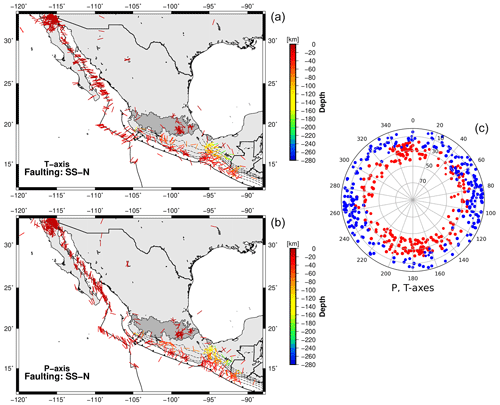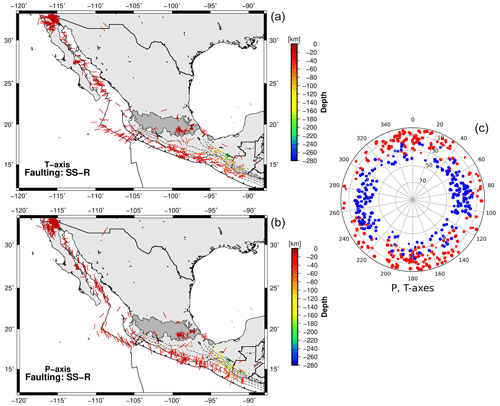the Creative Commons Attribution 4.0 License.
the Creative Commons Attribution 4.0 License.
An earthquake focal mechanism catalog for source and tectonic studies in Mexico from February 1928 to July 2022
Quetzalcoatl Rodríguez-Pérez
F. Ramón Zúñiga
We present a focal mechanism catalog for earthquakes that occurred in Mexico and surrounding areas reported from February 1928 to July 2022. The magnitude of the events varies from −0.9 to 8.2. The hypocentral depth is in the range of 0 < Z < 270 km. Focal mechanisms in this catalog are associated with tectonic, geothermal, and volcanic environments. Reported focal mechanisms were derived using different types of data at local, regional, and teleseismic distances and different methods such as first motions, composite solutions, waveform analysis, and moment tensor inversion. So far, focal mechanism data for earthquakes in Mexico are dispersed over many publications without any link among them. For this reason, we collect and revise focal mechanism solutions previously reported by different agencies and studies from published sources. Our catalog consists of 7664 focal mechanism solutions for a total of 5701 events since we report all the available focal mechanisms obtained by different authors and seismological agencies for each seismic event. Additionally, we classify the focal mechanisms according to their fault types using the ternary diagrams of Kaverina-type classification. We also rank the quality of the focal mechanism data into three categories: A, B, and C. A represents good/reliable data, B represents satisfactory data, and C represents poor/questionable data according to well-defined criteria. The main goal of this study is to provide a comprehensive compilation of focal mechanism data that can help in future source and tectonic studies in Mexico.
The earthquake focal mechanism catalog described in this article is available at https://doi.org/10.6084/M9.FIGSHARE.21663668.V1 (Rodríguez-Pérez and Zúñiga, 2022).
- Article
(12916 KB) - Full-text XML
- BibTeX
- EndNote
Earthquake catalogs are used in several tasks by seismologists daily. In most cases, seismic catalogs contain essential information such as origin time, hypocentral location, and magnitude of the events in a particular region. In other cases, the catalogs also include specific information such as fault planes, source duration, seismic wave phases, seismic source parameters, and finite-fault models (e.g., Ekström et al., 2012; Mai and Thingbaijam, 2014; Vallé and Douet, 2016; Di Giacomo et al., 2018; Rodríguez-Pérez et al., 2018). Studies related to seismicity and seismic hazard often require as input a seismic catalog that, in ideal conditions, contains information that has been derived in a homogenous way using the same procedures over some time (Cornell, 1968). Combining different datasets, and methods used to estimate a specific parameter, such as location or focal mechanism, can be an alternative form to increase the number of observations and enhance the resolution of an earthquake catalog. However, when combining different datasets, it is important to know the type and quality of data used and the advantages and limitations of the methods used to obtain a parameter reported in the catalogs. This study is focused on a compilation of an extensive earthquake focal mechanism catalog. Focal mechanisms describe the spatial fault orientation where earthquakes occur and the slip direction. Fault plane solutions are essential to understanding seismotectonic processes, such as studying the stress field in a given region. There are different methods available for determining focal mechanisms. One of the most common is based on P-wave polarities (Knopoff and Gilbert, 1960). The moment tensor inversion was introduced later, becoming one of the most popular methods up until the present day (e.g., Dziewonski et al., 1981; Pasyanos et al., 1996; Guilhem and Dreger, 2011).

Figure 1Probability density function and magnitude time series of seismic events with at least one focal mechanism reported in this catalog (a, b). The Kaverina rupture-type classification ternary diagram (c). Classification of focal mechanisms (d).
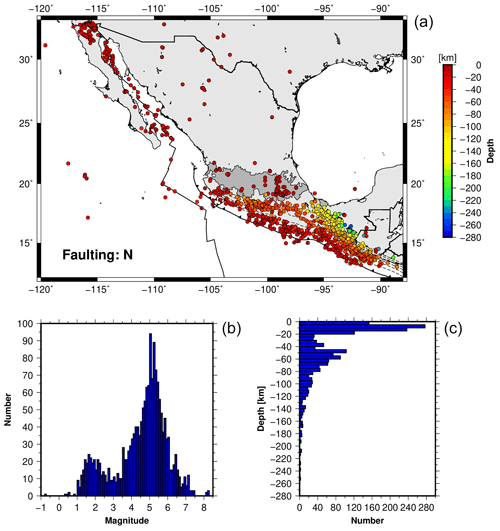
Figure 2Hypocentral distribution of normal faulting earthquakes (N) (a). Panels (b) and (c) show magnitude and hypocentral depth distributions.
Generally, the seismic source is considered as a point source located at the hypocenter; however, in other cases, the source can be assumed to be a centroid. The size of the earthquake plays an essential role in the source representation (Dziewonski and Woodhouse, 1983). For example, the difference between the centroid and the location of the rupture initiation can be significant. As a result, focal mechanisms derived from wave polarities and moment tensors differ not only due to inadequate velocity models or systematic errors. Focal mechanisms derived from P-wave polarities represent the geometry of the fault at the beginning of the rupture. Conversely, the moment tensor solutions provide the source mechanism of the predominant component of the seismic rupture. The difference between wave polarities and moment tensors is more drastic in the cases where the source deviates from a pure double couple representation. Nevertheless, the seismic polarity method is still in use despite its limitations, which can include incorrect polarity readings, inaccurate velocity models, and poor azimuthal coverage of stations, due to its simplicity and affordability. First motion polarities are often the only method used to derive focal mechanisms for small to moderate earthquakes (e.g., seismic swarms and aftershock sequences).
As a general practice, seismological observatories routinely compute moment tensors for earthquakes above a certain threshold of magnitude and publish their solutions in online catalogs. The threshold magnitudes of some of these agencies are MW=5.0 for the Global Centroid Moment Tensor (CMT) project (Dziewonski et al., 1981; Ekström et al., 2012), MW = 4.5 for the GEOFON Global Seismic Network, and MW=5.5 for the National Earthquake Information Center (NEIC) of the USGS (Benz, 2017). Similarly, there are local and regional moment tensors catalogs with lower threshold magnitudes (3.5 < MW < 4.5). Some other online databases, such as the focal mechanism bulletin of the International Seismological Centre (ISC) (Lentas and Harris, 2019; Lentas et al., 2019), contain both moment tensor solutions and wave polarities of global seismicity. Focal mechanisms have been computed and published in previous studies investigating seismotectonic features of specific regions. Several authors have made a considerable effort to determine focal mechanisms reported in different documents and also collect them in catalogs for specific areas to provide a set of revised information (e.g., Whidden and Pankow, 2012; Franco et al., 2020; Saraò et al., 2021). Many focal mechanism solutions are commonly spread out over different documents and locations, making standardizing information and checking and selecting parameters a painstaking job.
In Mexico, seismological agencies responsible for providing information about earthquakes must report focal mechanisms. The parameters routinely reported are the hypocentral location, magnitude, and origin time. This fact highlights the need to have a robust focal mechanism catalog. For this purpose, we study earthquakes with focal mechanisms in the region corresponding to the Mexican territory and surrounding areas (latitude 12–33∘ N and longitude 120–88∘ W). Mexico is one of the most seismically active regions in the world, where different tectonic environments co-occur (subduction zone, transform fault zones, and intraplate regions). In Mexico, most of the seismic activity is due to the interaction among five tectonic plates (North American, Pacific, Cocos, Rivera, and Caribbean) and, to a lesser extent but not unimportant in terms of hazard, due to the intraplate stresses located inland at tectonic plates. The region has experienced several shallow crustal intraplate, thrust subduction zone, and intra-slab earthquakes of great magnitude (7.0 < M < 8.2) over the past century, causing extensive damage to population centers, as in the case of the 12 November 1912 Acambay earthquake (M∼7.0), the 19 September 1985 Michoacán earthquake (M=8.2), and the 19 September 2017 earthquake (M=7.1), among others.
In light of the relevant seismic hazard in the region and its importance from the geodynamical perspective, many authors have computed the focal mechanisms of seismic events using different data and several techniques (e.g., Molnar and Sykes, 1969; Dean and Drake, 1978; Chael and Stewart, 1982; LeFevre and McNally, 1985; Goff et al., 1987; Guzmán-Speziale et al., 1989; Doser and Rodriguez, 1993; Pacheco et al., 1993; Pardo and Suárez, 1993; Pardo and Suárez, 1995; Quintanar et al., 1999; Rebollar et al., 1999; Quintanar et al., 2004; Rodríguez-Lozoya et al., 2008; Ortega and Quintanar, 2010; Pacheco and Singh, 2010; Sumy et al., 2013; Dougherty and Clayton, 2014; Abbott and Brudzinski, 2015; Rodríguez-Pérez and Singh, 2016; Huesca-Pérez et al., 2022). National and international observatories also provide focal mechanism solutions for seismic events generated in the territory of Mexico (e.g., the Mexican Seismological Service, SSN; the Southern California Seismic Network, SCSN; U.S. Geological Survey, USGS). In this study, we aim to collect and revise as many focal mechanisms as possible over time in a comprehensive catalog that can be a great starting point for future seismotectonic and seismic hazard studies.
2.1 Data
To collect information on focal mechanisms in Mexico, we first conduct a bibliographic search in libraries retrieving documents such as theses and reports. Secondly, individual published articles are found via different search engines such as Google Scholar, ResearchGate, and GeoScienceWorld. Finally, we search for focal mechanism solutions in catalogs reported by different seismic agencies. After examining information from several literature references and seismological agencies' catalogs, we find 5701 earthquakes with at least one fault plane solution. We report all the available focal mechanisms obtained by different authors and seismological agencies for each seismic event making the total number of focal mechanisms 7664. The compiled catalog has focal mechanism data from February 1928 to July 2022; the lowest data density is in the time interval of 1928–1970 (125 focal mechanisms) (Fig. 1a). Then, the number of focal mechanisms increased gradually between 1970 and 1995 (860 focal mechanisms) (Fig. 1). Since 1995, the number of focal mechanisms reported in Mexico has increased significantly (6679 focal mechanisms) (Fig. 1). The magnitude of these events fluctuates from −0.9 to 8.2, while the hypocentral depth is in the interval of 0 < Z < 270 km. The negative magnitude values are associated with microearthquakes in Sonora, located by Natali and Sbar (1982). These microearthquakes were detected using a 10-station temporal seismic network with the HYPOELLIPSE program (Lahr, 1979). We classify the focal mechanisms into three categories according to their general geological nature: (1) tectonic or regular, (2) geothermal, and (3) volcanic events.
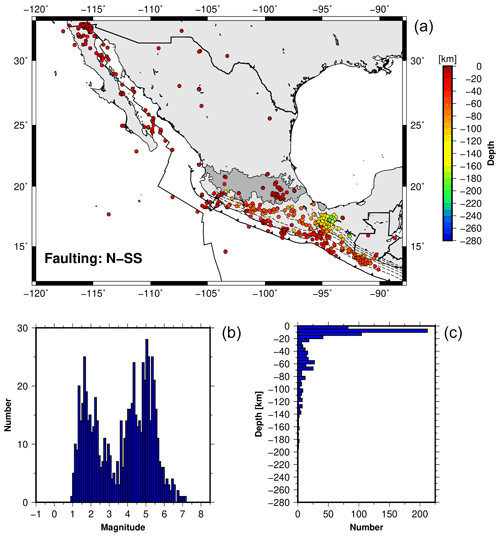
Figure 3Hypocentral distribution of normal faulting with a strike-slip component earthquakes (N-SS) (a). Panels (b) and (c) show magnitude and hypocentral depth distributions.
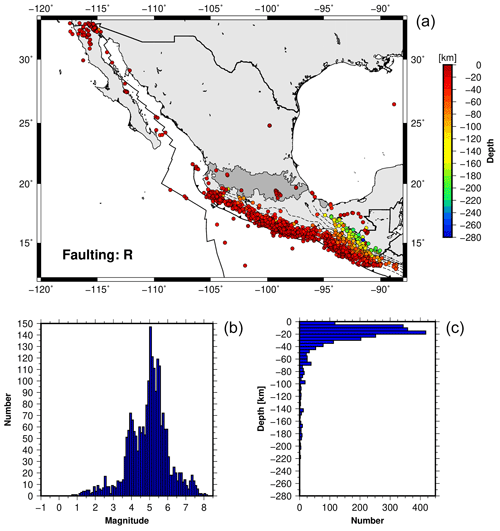
Figure 4Hypocentral distribution of reverse faulting (R) (a). Panels (b) and (c) show magnitude and hypocentral depth distributions.
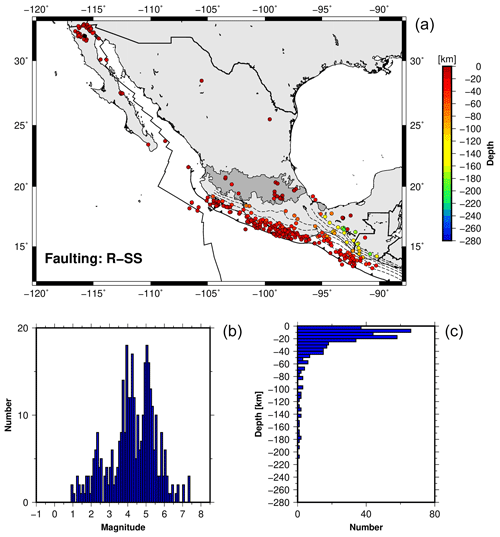
Figure 5Hypocentral distribution of reverse faulting with a strike-slip component (R-SS) (a). Panels (b) and (c) show magnitude and hypocentral depth distributions.
In our catalog, tectonic earthquakes comprise 7459 focal mechanisms reported in previous studies and for different seismological observatories using different data and methods (Molnar and Sykes, 1969; Thatcher and Brune, 1971; Molnar, 1973; Johnson et al., 1976; Jimenez-Jimenez, 1977; Dean and Drake, 1978; Ebel et al., 1978; Jimenez and Ponce, 1978; Kanamori and Stewart, 1978; Yamamoto, 1978; Reyes et al., 1979; Astiz, 1980; Morales-Matamoros, 1980; Zúñiga and Valdés-González, 1980; Chael and Stewart, 1982; Frohlich, 1982; Natali and Sbar, 1982; Domínguez-Reyes, 1983; Havskov et al., 1983; Astiz and Kanamori, 1984; Beroza et al., 1984; Burbach et al., 1984; González and Suárez, 1984; González et al., 1984; Lesage, 1984; Munguía and Brune, 1984; Yamamoto et al., 1984; LeFevre and McNally, 1985; Singh et al., 1985; González-Ruiz, 1986; Mota-Palomino et al., 1986; Ruiz-Kitcher, 1986; Suárez and Ponce, 1986; Yamamoto, 1986; Goff et al., 1987; González-Ruiz, 1987; Yamamoto and Mota, 1988; Yamamoto and Mitchell, 1988; Guzmán-Speziale et al., 1989; Domínguez-Rivas, 1991; Doser, 1992; Doser and Rodriguez, 1993; Pacheco et al., 1993; Pardo and Suárez, 1993; Singh and Pardo, 1993; Wolfe et al., 1993; Zúñiga et al., 1993; Cocco et al., 1994; Ruff and Miller, 1994; Santoyo-García-Galeano, 1994; Delgado-Vazquez, 1995; Pardo and Suárez, 1995; UNAM and CENAPRED Seismology group, 1995; Escobedo-Zenil, 1997; Wong et al., 1997; Pacheco and Singh, 1998; Quintanar et al., 1999; Rebollar et al., 1999; Singh et al., 1999; Terán-Mendieta, 1999; Campos-Enriquez et al., 2000; Cruz-Jiménez, 2000; Singh et al., 2000a, b; Delgadillo-Peralta, 2001; Rebollar et al., 2001; Iglesias et al., 2002; Yamamoto et al., 2002; Chavacán-Ávila, 2003; Pacheco et al., 2003; Sánchez-Alvaro, 2003; Singh et al., 2003; Zúñiga et al., 2003; Aguilar-Rosales, 2004; García et al., 2004; Núñez-Cornú et al., 2004; Quintanar et al., 2004; Hurtado-Díaz, 2005; Bernal-Esquia, 2006; González et al., 2006; Chavacán-Ávila, 2007; Singh et al., 2007a, b; Huesca-Pérez, 2008; Rodríguez-Lozoya et al., 2008; Ortega and Quintanar, 2010; Pacheco and Singh, 2010; Pérez-Campos et al., 2010; Rodríguez-Lozoya et al., 2010; Vidal et al., 2010; Jaramillo and Suárez, 2011; Martínez-López, 2011; Okal and Borrero, 2011; Stella-Ramírez, 2011; Singh et al., 2012; Soto-Peredo, 2012; Bello-Segura, 2013; Clemente-Chavez et al., 2013; Franco et al., 2013; Rutz-López et al., 2013; Sumy et al., 2013; UNAM Seismology Group, 2013; Yamamoto et al., 2013; De la Vega-Cabrera, 2014; Dougherty et al., 2014; Abbott and Brudzinski, 2015; Singh et al., 2015; Suárez and López, 2015; UNAM Seismology Group, 2015; Yamamoto and Jiménez, 2015; Granados-Chavarría, 2016; Gómez-Arredondo et al., 2016; Munguía et al., 2016a, b; Rodríguez-Cardozo, 2016; Rodríguez-Pérez and Singh, 2016; Suárez et al., 2016; Vallée and Douet, 2016; Singh et al., 2017; Yela-Portilla, 2018; Chávez-Hernández, 2019; Domínguez-Reyes et al., 2019; Quintanar et al., 2019; Méndez-Alarcón, 2020; Singh et al., 2020a, b; Mendoza-Zúñiga, 2021; Néquiz-Guillén, 2021; Núñez-Cornú et al., 2021; Sánchez-Lopez, 2021; Corona-Fernández and Santoyo, 2022; Huesca-Pérez et al., 2022).
Additionally, focal mechanisms of geothermal events include 151 events reported in the literature (Albores et al., 1980; Fabriol and Munguía, 1997; González et al., 2001; Rebollar et al., 2003; Antayhua-Vera, 2007; Suárez-Vidal et al., 2007; Romero-Domínguez, 2013; Pérez, 2017; Oregel-Morales, 2019; GEMex project, 2020). Finally, the volcanic earthquakes part consists of 54 focal mechanisms (Núñez-Cornú and Sánchez-Mora, 1998; Jimenez-Jimenez, 1999; Arámbula-Mendoza, 2007; Pinzón et al., 2017; Angulo-Carrillo, 2018; Núñez et al., 2022). Focal mechanisms reported in this catalog were derived with the following techniques: (1) regional and teleseismic moment tensor inversion (4747 fault plane solutions with 1.4 < M < 8.2), (2) waveform analysis (208 fault plane solutions with 1.4 < M < 8.1), and (3) first-motion wave polarities of single or composite mechanisms (2584 with 0.4 < M < 8.2, and 125 with −0.9 < M < 5.7, fault plane solutions, respectively).
2.2 Methods
After carefully searching focal mechanism solutions in the literature, we classify all the focal mechanisms in our catalog. For this purpose, we use the Focal Mechanisms Classification (FMC) computer program (Álvarez-Gómez, 2019). The software uses Kaverina-type classification diagrams (Kaverina et al., 1996) to verify the rupture type of the focal mechanism data. The Kaverina-type ternary diagrams classify earthquakes into seven rupture types based on the plunges of the P,B, and T principal axes: (1) normal (N), (2) normal–strike-slip (N-SS), (3) strike-slip–normal (SS-N), (4) strike-slip (SS), (5) strike-slip–reverse (SS-R), (6) reverse–strike-slip (R-SS), and (7) reverse (R) (Fig. 1c and d). Subsequently, we calculate the missing information of the fault/auxiliary planes, and principal axes. At this stage, we use the code library “cmt” of seizmo toolbox (Euler, 2014). Seizmo is a collection of different MATLAB libraries to perform different tasks in seismology. In particular, we use the library called “cmt”, which deals with obtaining auxiliary planes, calculating fault angles, and converting focal mechanisms, principal axes, and moment tensors. This library is made up of several functions, some of which we use and briefly describe below. We use the function “auxplane.m” to calculate the auxiliary focal plane. The function “sdr2tpb.m” is used to determine the principal axes of a focal mechanism. In some cases, we have to convert the moment tensor and principal axes to strike, dip, and rake angles. For that purpose, we use the function “tpb2sdr.m”. Transformations of moment tensors to strike–dip–rake are performed with the function “mt2sdr.m”. In cases where only the strike and dip of the fault and auxiliary planes were reported, the rake angles are calculated with the function “GetRake” of the RFOC package (Lees, 2018). RFOC is written in R language and deals with graphics for statistics on a sphere, earthquake focal mechanisms, radiation patterns, and ternary plots.
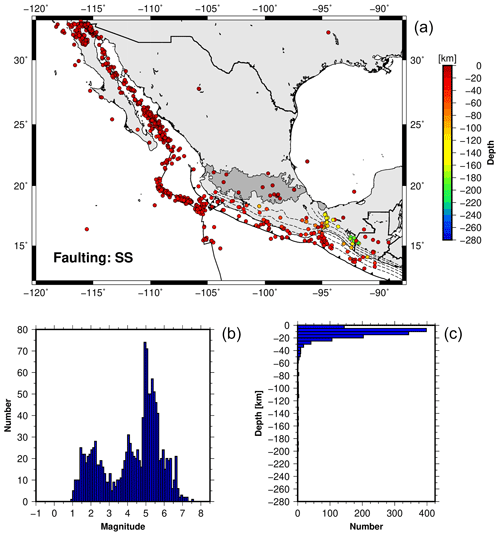
Figure 6Hypocentral distribution of strike-slip faulting (SS) (a). Panels (b) and (c) show magnitude and hypocentral depth distributions.
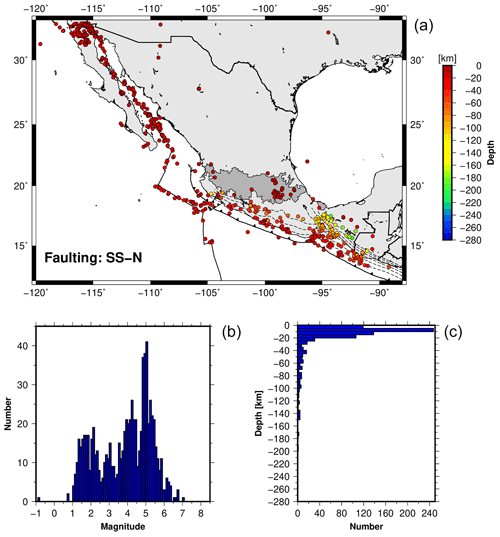
Figure 7Hypocentral distribution of strike-slip faulting with a normal component (SS-N) (a). Panels (b) and (c) show magnitude and hypocentral depth distributions.
Our database merges focal mechanism solutions from different studies that used different methodologies, each with a different uncertainty level. To address this variability in data and methods, we rank the quality and reliability of the focal mechanisms in our catalog using the following criteria. We assign a quality factor based on data availability and the calculation process. For data availability, we consider the number of observations, quality of the records (e.g., digitized seismograms, type of instrument), and their spatial distribution (hypocentral distance and station coverage). Regarding the calculation process, we consider the uniformity of the method throughout the reported study, the methodology's description, and the method's calibration (selection of input parameters for the method chosen to calculate focal mechanisms or moment tensors). A good calibration considers a correct selection of the medium's properties, especially the velocity model used to calculate travel times or synthetic seismograms. Due to the lack of uncertainty estimates reported in several studies, we do not consider them for assigning a quality factor in most fault plane solutions. The quality of the moment tensor solutions is assigned based on the overall variance reduction (VR). The VR describes the goodness of fit between observed and synthetic waveforms of the moment tensor inversion. We only considered VR to assign a quality factor when it was available. Franco et al. (2020) studied seismic moment tensors in Mexico, and they established that a value of VR ≥ 50 % is a reasonable threshold for reliable focal mechanism solutions.
We classify the focal mechanism data into three categories: A, B, and C. A represents good/reliable data, B represents satisfactory data, and C represents poor/questionable data. Category A has one or more of the following characteristics: an adequate velocity structure, a VR of > 70 %, an adequate number of observations, a good spatial distribution of observations, a uniform methodology (avoiding the use of several methods to obtain parameters and mix the results), a good description of the method (advantages and disadvantages of the technique used) and data processing, and modern seismic instrumentation. Category B has one or more of the following characteristics: an adequate velocity model, a VR range of 50 % < VR < 70 %, few observations, a regular spatial distribution of observations, a uniform methodology, and a good description of the method and data processing. Category C has one or more of the following characteristics: a global/mean velocity model, a VR of < 50 %, few observations, poor spatial distribution of observations, nonuniform methodology, a poor description of the method and data processing, and analog instrumentation. Here, the term adequate velocity model refers to the model being specific to the region where the earthquakes are generated, since, in many cases, average models are used that cover vast regions of the territory of Mexico. The quality criterion presented here may help the user decide if the selected focal mechanisms are suitable for their analysis or study. For each focal mechanism solution, we show all the magnitudes reported. An event can have a different type of magnitude. Given all the different magnitude scales, compiling a unified magnitude scale is a demanding task requiring further detailed analysis outside this study's scope. In addition, the main objective of this study is the focal mechanisms per se.
We provide our catalog in ASCII and Excel files entitled “Focal_mechanisms_Mexico_1928-2022”. In this file, we provide the following information: (1) event number, (2) number of solutions named, S-1, S-2, and S-n, where n is the number of a solution, (3) date of the event, (4) origin time, (5) longitude of the epicenter, (6) latitude of the epicenter, (7) hypocentral depth, (8) magnitude for each of the solutions, (9) rupture type (N, N-SS, SS-N, SS, SS-R, R-SS, and R), (10) strike angle 1, (11) dip angle 1, (12) rake angle 1, (13) strike angle 2, (14) dip angle 2, (15) rake angle 2, (16) plunge of the T axis, (17) azimuth of the T axis, (18) plunge of the P axis, (19) azimuth of the P axis, (20) plunge of the B axis, (21) azimuth of the B axis, (22) tectonic environment (tectonic, geothermal zone or volcanic), (23) observations of the event (here we reported the type of magnitude for each of the solutions, , and Mc), (24) method used to determine the focal mechanism (first arrivals, composite solution, waveform analysis, moment tensor), (25) variance reduction when the information was available, (26) quality of the event, and (27) bibliographical references or seismological agency. When information (origin time, seismic magnitude, or hypocentral depth) is missing, the database cell is highlighted in red, and a question mark is also shown in the cell.
The information in this catalog is presented in an easy-to-understand manner as an aid to the user. The classification of focal mechanisms in our catalog yielded 1750 events with normal faulting (Fig. 2). Earthquakes with N-SS faulting include 691 events (Fig. 3). On the other hand, reverse-faulting forms a group of 2248 earthquakes (Fig. 4). R-SS faulting consists of 351 events (Fig. 5). Pure strike-slip rupture is made up of 1320 seismic events (Fig. 6). SS-N faulting comprises a group of 792 earthquakes (Fig. 7). SS-R faulting is made up of 512 seismic events (Fig. 8). The earthquake magnitude distribution for all types of faulting exhibits bimodal distributions (Figs. 2 to 8). Several factors can explain this. For one, the earthquake detection capability of permanent seismic networks has improved with new developments and densification of seismometers. Secondly, it is also due to the use of temporary networks used to study aftershock sequences and seismic swarms.
In Figs. 9 to 15, we show the orientation of the pressure and tension axes. Some conspicuous differences can already be distinguished among the different tectonic regimes. We provide some statistics on P and T axes for each type (Table 1), which may serve as a first step to a more detailed analysis since this is not the aim of this work. We interpret the large deviations from the main trends in data presented in Table 1 as arising from the mixture of tectonic regimes involved in the average; these should decrease when differentiating among such regimes. Nevertheless, the azimuths of the P and T axes primarily reflect the expected conditions of subduction for R-type events, which dominate this tectonic environment, as well as the trends of transform faults in the case of SS type. N-type events comprise a mixture of tectonic regimes, which precludes identifying a particular regime as dominating the whole data set. Even though a detailed tectonic analysis is out of the scope of this work, we believe that the data presented here will make such a task more accessible and provide a basis for systematic comparison.
Table 1Mean and standard deviations for the principal stress axes trends for each type of mechanism.
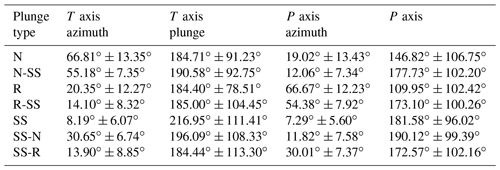

Figure 9Spatial distribution of T and P axes for normal faulting earthquakes (N) (a, b, respectively). Distribution of P and T axes (red and blue colors, respectively) (c).

Figure 10Spatial distribution of T and P axes for normal faulting with a strike-slip component earthquakes (N-SS) (a, b, respectively). Distribution of P and T axes (red and blue colors, respectively) (c).

Figure 11Spatial distribution of T and P axes for reverse faulting (R) (a, b, respectively). Distribution of P and T axes (red and blue colors, respectively) (c).
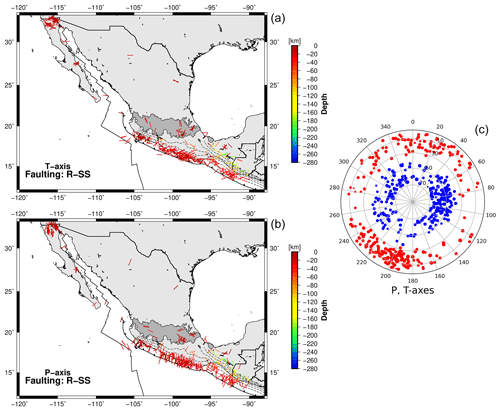
Figure 12Spatial distribution of T and P axes for reverse faulting with a strike-slip component (R-SS) (a, b, respectively). Distribution of P and T axes (red and blue colors, respectively) (c).
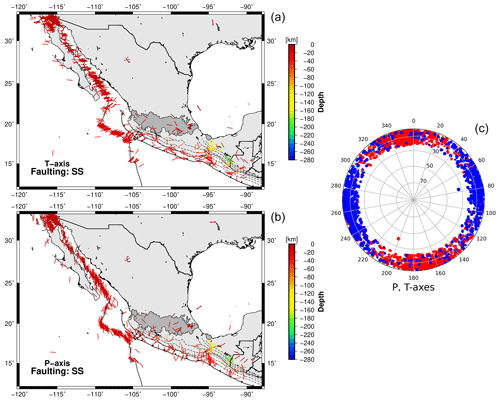
Figure 13Spatial distribution of T and P axes for strike-slip faulting (SS) (a, b, respectively). Distribution of P and T axes (red and blue colors, respectively) (c).
Some focal mechanisms described in this article are available at the following data sources: (1) Global Centroid Moment Tensor (Global CMT) via https://www.globalcmt.org (Dziewonski et al., 1981; Ekström et al., 2012), (2) Mexican Global Centroid Moment Tensor via http://132.248.6.13/cmt (Franco et al., 2020), (3) GEOFON Global Seismic Network via https://doi.org/10.17616/R36613 (re3data.org, 2023), (4) International Seismic Centre (ISC) bulletin (https://doi.org/10.31905/D808B830, International Seismological Centre, 2022), (5) U.S. Geological Survey (USGS), National Earthquake Information Center (NEIC) via https://earthquake.usgs.gov/earthquakes/search (Masse and Needham, 1989), (6) Saint Louis University moment tensor catalog via http://www.eas.slu.edu/eqc/eqc_mt/MECH.NA (Herrman et al., 2011), (7) SCARDEC Source Time Functions Database via http://scardec.projects.sismo.ipgp.fr (Vallée and Douet, 2016), and (8) Southern California Earthquake Data Center (SCEDC) earthquake catalogs via https://service.scedc.caltech.edu/eq-catalogs/FMsearch.php (Yang et al., 2012) and https://doi.org/10.7914/SN/CI (SCEDC catalogs are collected by the Southern California Seismic Network (SCSN), a cooperative project of California Institute of Technology and the United States Geological Survey). In all cases, the date of last access is 17 September 2022. The focal mechanism catalog derived from this study is available in Rodríguez-Pérez and Zúñiga (2022, https://doi.org/10.6084/M9.FIGSHARE.21663668.V1).
All figures were plotted by the Generic Mapping Tools software package (https://www.generic-mapping-tools.org, last access: October 2023, Wessel et al., 2013). Earthquake fault classification was performed with FMC software (https://github.com/Jose-Alvarez/FMC, last access: October 2023, Álvarez-Gómez, 2019). Conversions among fault planes, principal axes, and/or moment tensors were performed with RFOC and seizmo cmt codes (https://github.com/cran/RFOC, last access: October 2023, Lees, 2018; and https://github.com/g2e/seizmo, last access: October 2023, Euler, 2014).
We collect and revise focal mechanism solutions previously reported by different agencies and studies from published sources to compile a catalog of focal mechanisms for Mexico. Our catalog consists of 7664 solutions for 5701 local and regional events. From these, 1750 events correspond to normal faulting, 691 events to N-SS, 2248 to pure reverse, 351 to R-SS, 1320 to pure strike-slip, 792 to SS-N, and 512 to SS-R faulting. These account for 32 % of the solutions corresponding to normal in general, 34 % corresponding to reverse, and 34 % corresponding to the dominant strike-slip type. Besides including all information about the source of the data, we also ranked the quality of the focal mechanism data into three categories: A, B, and C. A represents good/reliable data, B represents satisfactory data, and C represents poor/questionable data according to robust criteria. Moment tensor inversion involves many assumptions and constraints that make evaluating confidence in fault planes difficult. For this reason, we present all the focal mechanism solutions available for one event. In this way, users can consider the variability of the focal mechanisms in their analysis.
QRP and FRZ designed the idea and discussed the results. QRP was responsible for the data collection and earthquake selection. The two authors contributed to the article and approved the final version.
The contact author has declared that neither of the authors has any competing interests.
Publisher's note: Copernicus Publications remains neutral with regard to jurisdictional claims made in the text, published maps, institutional affiliations, or any other geographical representation in this paper. While Copernicus Publications makes every effort to include appropriate place names, the final responsibility lies with the authors.
Constructive reviews by two anonymous reviewers helped to improve the article.
Quetzalcoatl Rodríguez-Pérez was supported by the Mexican National Council for Science and Technology (CONACYT) (research project no. 1126). Partial support for F. Ramón Zúñiga was obtained from grant no. PAPIIT-UNAM IG101823, which is also acknowledged.
This paper was edited by Kirsten Elger and reviewed by two anonymous referees.
Abbott, E. R. and Brudzinski, M. R.: Shallow seismicity patterns in the northwestern section of the Mexico Subduction Zone, J. S. Am. Earth Sci., 63, 279–292, https://doi.org/10.1016/j.jsames.2015.07.012, 2015.
Aguilar-Rosales, M. A.: Determinación del tipo de fuentes sísmicas dentro de la Cuenca de México y sus relación con la geologia local, B.Eng. thesis, UNAM, Mexico, 38 pp., https://hdl.handle.net/20.500.14330/TES01000338996, 2004.
Albores, A., Reyes, A., Brune, J. N., Gonzalez, J., Garcilazo, L., and Suarez, F.: Seismicity studies in the region of the Cerro Prieto Geothermal field, Geothermics, 9, 65–77, https://doi.org/10.1016/0375-6505(80)90024-3, 1980.
Álvarez-Gómez, J. A.: FMC- Earthquake focal mechanisms data management, cluster and classification, Software X, 9, 299–307, https://doi.org/10.1016/j.softx.2019.03.008, 2019.
Angulo-Carrillo, J.: Análisis de la actividad sísmica e hidrotermal del Volcán La Malinche, México, M.S. thesis, UNAM, Mexico, 85 pp., https://hdl.handle.net/20.500.14330/TES01000775962, 2018.
Antayhua-Vera, Y. T.: Sismicidad en el campo geotermico de los Humeros-Puebla (1997–2004), su relacion con los pozos y la tectonica local, M.S. thesis, UNAM, Mexico, 225 pp., https://hdl.handle.net/20.500.14330/TES01000697555, 2007.
Arámbula-Mendoza, R.: Estado de esfuerzos en el Volcán Popocatépetl obtenido con mecanismos focales, en el periodo de actividad de 1996 a 2003, M.S. thesis, UNAM, Mexico, 122 pp., https://hdl.handle.net/20.500.14330/TES01000619886, 2007.
Astiz, L. M.: Sismicidad en Acambay, Estado de Mexico. El temblor del 22 de febrero de 1979, B.Eng. thesis, UNAM, Mexico, 130 pp., https://hdl.handle.net/20.500.14330/TES01000021837, 1980.
Astiz, L. M. and Kanamori, H.: An earthquake doublet in Ometepec, Guerrero, Mexico, Phys. Earth Planet. Int., 34, 24–45, https://doi.org/10.1016/0031-9201(84)90082-7, 1984.
Bello-Segura, D. I.: Parámetros de la fuente de sismos con epicentros en el Valle de México durante 2008–2012, M.S. thesis, UNAM, Mexico, 85 pp., https://hdl.handle.net/20.500.14330/TES01000706225, 2013.
Benz, H.: Building a National Seismic Monitoring Center: NEIC from 2000 to the Present, Seismol. Res. Lett., 88, 457–461, https://doi.org/10.1785/0220170034, 2017.
Bernal-Esquia, Y. I.: Microzonificacion sismica de la Ciudad de Tlaxcala, Mexico, M.S. thesis, UNAM, 130 pp., https://hdl.handle.net/20.500.14330/TES01000608034, 2006.
Beroza, G., Rial, J. A., and McNally, K. C.: Source mechanisms of the June 7, 1982 Ometepec, Mexico earthquake, Geophys. Res. Lett., 11, 689–692, https://doi.org/10.1029/GL011i008p00689, 1984.
Burbach, G., Frolich, C., Pennington, W., and Matumoto, T.: Seismicity and tectonics of the subducted Cocos plate, J. Geophys. Res., 89, 7719–7735, https://doi.org/10.1029/JB089iB09p07719, 1984.
California Institute of Technology and United States Geological Survey Pasadena: Southern California Seismic Network, https://doi.org/10.7914/SN/CI, 1926.
Campos-Enriquez, J. O., Rodríguez, M., Delgado-Rodríguez, O., and Milán, M.: Contribution to the tectonics of the northern portion of the central sector of the trans-Mexican Volcanic Belt, Geol. Soc. Am., 334, 223–235, https://doi.org/10.1130/0-8137-2334-5.223, 2000.
Chael, E. P. and Stewart, G. S.: Recent large earthquakes along the Middle American Trench and their implications for the subduction process, J. Geophys. Res., 87, 329–338, https://doi.org/10.1029/JB087iB01p00329, 1982.
Chavacán-Ávila, M. R.: Catalogo de sismicidad local para la Cuenca de Mexico, M.S. thesis, UNAM, Mexico, 159 pp., https://hdl.handle.net/20.500.14330/TES01000618079, 2007.
Chavacán-Avila, M. R.: Parámetros de fuente asociados a la sismicidad del sistema de fallas de la Sierra del Chichinautzin, B.Eng. thesis, UNAM, Mexico, 90 pp., https://hdl.handle.net/20.500.14330/TES01000320606, 2003.
Chávez-Hernández, O. C.: Determinación de mecanismos focales en el Valle de México durante el periodo 2014–2016, B.Eng. thesis, IPN, Mexico, 68 pp., http://tesis.ipn.mx/handle/123456789/29975, 2019.
Clemente-Chavez, A., Figueroa-Soto, A., Zúñiga, F. R., Arroyo, M., Montiel, M., and Chavez, O.: Seismicity at the northeast edge of the Mexican Volcanic Belt (MVB) and activation of an undocumented fault: the Peñamiller earthquake sequence of 2010–2011, Querétaro, Mexico, Nat. Hazards Earth Syst. Sci., 13, 2521–2531, https://doi.org/10.5194/nhess-13-2521-2013, 2013.
Cocco, M., Pacheco, J., Singh, S. K., and Courboulex, F.: The Zihuatanejo, Mexico, earthquake of 1994 December 10 (M= 6.6): source characteristics and tectonic implications, Geophys. J. Int., 131, 135–145, https://doi.org/10.1111/j.1365-246X.1997.tb00600.x, 1997.
Cornell, C. A.: Engineering seismic risk analysis, B. Seismol. Soc. Am., 58, 1583–1606, https://doi.org/10.1785/BSSA0580051583, 1968.
Corona-Fernández, R. D. and Santoyo, M. A.: Re-examination of the 1928 Parral, Mexico earthquake (M6.3) using a new multiplatform graphical vectorization and correction software for legacy seismic data, Geosci. Data J., 10, 1–15, https://doi.org/10.1002/gdj3.159, 2022.
Cruz-Jiménez, H.: Análisis de las réplicas de los sismos del 3 (M= 4.1) y 5 (M= 4.2) de junio de 1996 en Bella Vista, Querétaro, B.Eng. thesis, IPN, Mexico, 95 pp., 2000.
Dean, B. W. and Drake, C. L.: Focal mechanism solutions and tectonics of the Middle America arc, J. Geol., 86, 111–128, https://doi.org/10.1086/649659, 1978.
De la Vega-Cabrera, O. O.: Un método de inversion del tensor de momento sismico: implementacion y aplicacion a las replicas del temblor de 20 de marzo 2012, Ometepec, Guerrero, UNAM, Mexico, B. Eng. thesis, 114 pp., https://hdl.handle.net/20.500.14330/TES01000708658, 2014.
Delgadillo-Peralta, M.: Un estudio de sismicidad en el Valle de México durante el periodo de 1996 al 2000. B.Eng. thesis, UNAM, Mexico, 63 pp., https://hdl.handle.net/20.500.14330/TES01000300224, 2001.
Delgado-Vazquez, M. A.: Zonificacion sismica para la zona urbana de Guadalajara, B.Eng. thesis, UNAM, Mexico, 95 pp., https://hdl.handle.net/20.500.14330/TES01000227931, 1995.
Di Giacomo, D., Engdahl, E. R., and Storchak, D. A.: The ISC-GEM Earthquake Catalogue (1904–2014): status after the Extension Project, Earth Syst. Sci. Data, 10, 1877–1899, https://doi.org/10.5194/essd-10-1877-2018, 2018.
Domínguez-Reyes, T.: Estudio del temblor de Tehuantepec del 22 de Junio de 1979 (mb- 6.2, h-113 km) mediante modelado de ondas de cuerpo, B.Eng. thesis, UNAM, Mexico, 48 pp., https://hdl.handle.net/20.500.14330/TES01000021880, 1983.
Domínguez-Reyes, T., Rodríguez Lozoya, H. E., Reyes, G., Quintanar Robles, L., Aguilar Meléndez, A., and Rodríguez Leyva, H. E.: Sorce parameters, focal mechanisms and stress tensor inversion from moderate earthquakes and its relationship with subduction zone, Geofis. Int., 58, 127–137, https://doi.org/10.22201/igeof.00167169p.2018.58.2.1965, 2019.
Domínguez-Rivas, J.: Geometría de la Placa de Cocos en la región del río Balsas, Guerrero, B.Eng. thesis, UNAM, Mexico, 72 pp., https://hdl.handle.net/20.500.14330/TES01000152096, 1991.
Doser, D. I.: Faulting process of the 1956 San Miguel, Baja California, earthquake sequence, Pure Appl. Geophys., 139, 3–16, https://doi.org/10.1007/BF00876824, 1992.
Doser, D. I. and Rodriguez, J.: The seismicity of Chihuahua, Mexico, and the 1928 Parral earthquake, Phys. Earth Planet. Int., 78, 97–104, https://doi.org/10.1016/0031-9201(93)90086-O, 1993.
Dougherty, S. L. and Clayton, R. W.: Seismicity and structure in central Mexico: evidence for a possible slab tear in the South Cocos plate, J. Geophys. Res., 119, 3424–3447, https://doi.org/10.1002/2013JB010883, 2014.
Dziewonski, A. M., Chou, T. A., and Woodhouse, J. H.: Determination of earthquake source parameters from waveform data for studies of global and regional seismicity, J. Geophys. Res., 86, 2825–2852, https://doi.org/10.1029/JB086iB04p02825, 1981.
Dziewonski, A. M. and Woodhouse, J. H.: An experiment in systematic study of global seismicity: centroid-moment tensor solutions for 201 moderate and large earthquakes of 1981, J. Geophys. Res., 88, 3247–3271, https://doi.org/10.1029/JB088iB04p03247, 1983.
Ebel, J. E., Burdick, L. J., and Stewart, G. S.: The source mechanism of the August 7, 1966 El Golfo earthquake, B. Seismol. Soc. Am., 68, 1281–1292, https://doi.org/10.1785/BSSA0680051281, 1978.
Ekström, G., Nettles, M., and Dziewonski, A. M.: The global CMT project 2004–2010: Centroid-moment tensors for 13,017 earthquakes, Phys. Earth Planet. Int., 200–201, 1–9, https://doi.org/10.1016/j.pepi.2012.04.002, 2012.
Escobedo-Zenil, D.: El sismo del 09 de Octubre de 1995 en Colima, Un estudio telesísmico, M.S. thesis, UNAM, Mexico, 67 pp., https://hdl.handle.net/20.500.14330/TES01000249023, 1997.
Euler, G. G.: Seizmo package, https://github.com/g2e/seizmo (last access: October 2023), 2014.
Fabriol, H. and Munguía, L.: Seismic activity at the Cerro Prieto geothermal area (Mexico) from August 1994 to December 1995, and its relationship with tectonics and fluid exploitation, Geophys. Res. Lett., 24, 1807–1810, https://doi.org/10.1029/97GL01669, 1997.
Franco, S. I., Canet, C., Iglesias, A., and Valdés-Gonzalez, C.: Seismic activity in the Gulf of Mexico. A preliminary analysis, Bol. Soc. Geol. Mex., 65, 447–455, https://doi.org/10.18268/BSGM2013v65n3a2, 2013.
Franco, S. I., Iglesias, A., and Fukuyama, E.: Moment tensor catalog for Mexican earthquakes: almost two decades of seismicity, Geofis. Int., 59, 54–82, https://doi.org/10.22201/igeof.00167169p.2020.59.2.2081, 2020.
Frohlich, C.: Seismicity of the central Gulf of Mexico, Geology, 10, 103–106, https://doi.org/10.1130/0091-7613(1982)10<103:SOTCGO>2.0.CO;2, 1982.
García, D., Singh, S. K., Herrádiz, M., Pacheco, J. F., and Ordaz, M.: Inslab earthquakes of Central Mexico: Q, source spectra, and stress drop, Bull. Seismol. Soc. Am., 94, 789–802, https://doi.org/10.1785/0120030125, 2004.
GEMex project: Seismic structures of the Acoculco and Los Humeros geothermal fields, European Union's Horizon 2020 programme for Research and Innovation, Open File Rep. D5.3, 128 pp., https://www.gemex-h2020.eu/index.php?option=com_content&view=article&id=12&catid=2&lang=en&Itemid=114 (last access: October 2023), 2020.
Goff, J. A., Bergman, E. A., and Solomon, S. C.: Earthquake source mechanisms and transform fault tectonics in the Gulf of California, J. Geophys. Res., 92, 10485–10510, https://doi.org/10.1029/JB092iB10p10485, 1987.
Gómez-Arredondo, C. M., Montalvo-Arrieta, J. C., Iglesias-Mendoza, A., and Espindola-Castro, V. H.: Relocation and seismotectonic interpretation of the seismic swarm of August–December of 2012 in the Linares area, northeastern Mexico, Geofis. Int., 55, 95–106, https://doi.org/10.22201/igeof.00167169p.2016.55.2.1714, 2016.
González, J., Nava, F. A., and Reyes, C. A.: Foreshock and aftershock activity of the 1976 Mesa de Andrade, Mexico, earthquake, B. Seismol. Soc. Am., 74, 223–233, https://doi.org/10.1785/BSSA0740010223, 1984.
González, J. J. and Suárez, F.: Geological and seismic evidence of a new branch of the Agua Blanca Fault, Geophys. Res. Lett., 11, 42–45, https://doi.org/10.1029/GL011i001p00042, 1984.
González, M., Munguía, L., Vidal, A., and Wong, V.: Two MW 4.8 Cerro Prieto, Baja California, México, earthquakes on 1 June and 10 September 1999: strong-motion observations, B. Seismol. Soc. Am., 91, 1456–1470, https://doi.org/10.1785/0120000033, 2001.
González, M., Vidal, A., and Munguía, L.: An ML scale for the La Paz-Los Cabos region, Baja California Sur, Mexico, B. Seismol. Soc. Am., 96, 1296–1304, https://doi.org/10.1785/0120050196, 2006.
González-Ruiz, J.: Earthquake source rnechanics and tectonophysics of the middle America subduction zone in Mexico, Ph.D. Thesis, U. of California, Santa Cruz, 1986.
Gonzalez-Ruiz, L. C.: Patrones de sismicidad en Guerrero y peligro sismico, M.S. thesis, UNAM, Mexico, 69 pp., https://hdl.handle.net/20.500.14330/TES01000057548, 1987.
Granados-Chavarría, I.: Analisis de los sismos de Julio de 2012 en el Valle de Chalco, Estado de Mexico: estudios de fuente y efectos en superficie, B.Eng. thesis, UNAM, Mexico, 115 pp., https://hdl.handle.net/20.500.14330/TES01000739713, 2016.
Guilhem, A. and Dreger, D. S.: Rapid detection and characterization of large earthquakes using quasi-finite-source Green's functions in continuous moment tensor inversion, Geophys. Res. Lett., 38, L13318, https://doi.org/10.1029/2011GL047550, 2011.
Guzmán-Speziale, M., Pennington, W. D., and Matumoto, T.: The triple junction of the North America Cocos, and Caribbean plates: seismicity and tectonics, Tectonics, 8, 981–997, https://doi.org/10.1029/TC008i005p00981, 1989.
Havskov, J., Singh, S. K., Nava, E., Dominguez, T., and Rodríguez, M.: Playa Azul, Michoacan, Mexico, earthquake of 25 October 1981 (Ms= 7.3), B. Seismol. Soc. Am., 73, 449–457, 1983.
Herrman, R. B., Benz, H., and Ammon, C. J.: Monitoring the earthquake source process in North America, B. Seismol. Soc. Am., 101, 2609–2625, https://doi.org/10.1785/0120110095, 2011.
Huesca-Pérez, E.: Sismicidad y el campo de esfuerzos en la Cuenca de Mexico, M.S. thesis, UNAM, Mexico, 118 pp., https://hdl.handle.net/20.500.14330/TES01000631690, 2008.
Huesca-Pérez, E., Gutierrez-Reyes, E., and Quintanar, L.: Seismic source processes of 25 earthquakes (MW > 5) in the Gulf of California, B. Seismol. Soc. Am., 112, 714–733, https://doi.org/10.1785/0120210218, 2022.
Hurtado-Díaz, A.: Geometria y estado de esfuerzos de la zona de Benioff de la placa de Rivera bajo el Bloque de Jalisco, B.Eng. thesis, UNAM, Mexico, 61 pp., 2005.
Iglesias, A., Singh, S. K., Pacheco, J. F., and Ordaz, M.: A source and wave propagation study of the Copalillo, Mexico, earthquake of 21 July 2000 (Mw 5.9): implications for seismic hazard in Mexico City from inslab earthquakes, B. Seismol. Soc. Am., 92, 1060–1071, https://doi.org/10.1785/0120010144, 2002.
International Seismological Centre: On-line Bulletin, https://doi.org/10.31905/D808B830, 2022.
Jaramillo, S. H. and Suárez, G.: The 4 december 1948 earthquake (Mw 6.4): evidence of reverse faulting beneath the Tres Marías escarpment and its implications for the Rivera-North American relative plate motion, Geofis. Int., 50, 313–317, https://doi.org/10.22201/igeof.00167169p.2011.50.3.229, 2011.
Jimenez, Z. and Ponce, L.: Focal mechanism of six large earthquakes in Northern Oaxaca, Mexico, for the period 1928–1973, Geofis. Int., 17, 379–386, https://doi.org/10.22201/igeof.00167169p.1978.17.3.1059, 1978.
Jimenez-Jimenez, Z.: Mecanismo focal de siete temblores (mb≥5.5) ocurridos en la región de Orizaba, México, en el periodo de 1928 a 1973, B.Eng. thesis, UNAM, Mexico, 102 pp., https://hdl.handle.net/20.500.14330/TES01000072217, 1977.
Jimenez-Jimenez, Z.: Evolución del proceso eruptivo del Volcán El Chichón de Marzo-Abril de 1982, M.S. thesis, UNAM, Mexico, 102 pp., https://hdl.handle.net/20.500.14330/TES01000272990, 1999.
Johnson, T. L., Madrid, J., and Koczynski, T.: A study of microseismicity in Northern Baja California, Mexico, B. Seismol. Soc. Am., 66, 1921–1929, https://doi.org/10.1785/BSSA0660061921, 1976.
Kanamori, H. and Stewart, G.: Seismological aspects of the Guatemala earthquake of February 4, 1976, J. Geophys. Res., 83, 3427–3434, https://doi.org/10.1029/JB083iB07p03427, 1978.
Kaverina, A. N., Lander, A. V., and Prozorov, A. G.: Global creepex distribution and its relation to earthquake-source geometry and tectonic origin, Geophys. J. Int., 125, 249–265, https://doi.org/10.1111/j.1365-246X.1996.tb06549.x, 1996.
Knopoff, L. and Gilbert, F.: First motions from seismic sources, B. Seismol. Soc. Am., 50, 117–134, https://doi.org/10.1785/BSSA0500010117, 1960.
Lahr, J. C.: HYPOELLIPSE: a computer program for determining local earthquake hypocenter parameters, magnitude and first motion pattern, U.S. Geol. Surv., Open-File Rept, 79-431, 57 pp., https://doi.org/10.3133/ofr79431, 1979.
LeFevre, L. V. and McNally, K. C.: Stress distribution and subduction of aseismic ridges in the Middle America subduction zone, J. Geophys. Res., 90, 4495–4510, https://doi.org/10.1029/JB090iB06p04495, 1985.
Lees, J. M.: RFOC. Graphics for Spherical Distributions and Earthquake FocalMechanisms, R package, R Foundation for Statistical Computing, Vienna, Austria, https://cran.r-project.org/web/packages/RFOC/index.html (last access: October 2023), 2018.
Lentas, K. and Harris, J.: Enhanced performance of ISC focal mechanism computations as a result of automatic first-motion polarity picking optimization, J. Seismol., 23, 1141–1159, https://doi.org/10.1007/s10950-019-09862-x, 2019.
Lentas, K., Di Giacomo, D., Harris, J., and Storchak, D. A.: The ISC Bulletin as a comprehensive source of earthquake source mechanisms, Earth Syst. Sci. Data, 11, 565–578, https://doi.org/10.5194/essd-11-565-2019, 2019.
Lesage, P.: Determinacion de parametros focales del temblor de Huajuapan de Leon, Oaxaca, del 24 de Octubre de 1980, usando sismogramas sinteticos de ondas compresionales y un metodo de inversion linealizada, Geofis. Int., 23, 57–72, https://doi.org/10.22201/igeof.00167169p.1984.23.1.796, 1984.
Mai, P. M. and Thingbaijam, K. K. S.: SRCMOD: An online database of finite-fault rupture models, Seismol. Res. Lett., 85, 1348—1357, https://doi.org/10.1785/0220140077, 2014.
Martínez-López M. R.: Estudio sismico de la estructura cortical en el bloque de Jalisco a partir de registros locales del proyecto MARS, M.S. thesis, UNAM, Mexico, 129 pp., https://hdl.handle.net/20.500.14330/TES01000667086, 2011.
Masse, R. P. and Needham, R. E.: NEIC – The National Earthquake Information Center, Earthquakes and Volcanoes, USGS, 21, 4–44, 1989. -
Méndez-Alarcón, M. A.: Análisis del sismo del 19 de septiembre del 2017 y su secuencia de réplicas, B.Eng. thesis, UNAM, Mexico, 108 pp., https://hdl.handle.net/20.500.14330/TES01000812837, 2020.
Mendoza-Zúñiga, J. F.: Fallamiento asociado a la sismicidad mayor ocurrida en el Valle de México durante 2017, B.Eng. thesis, UNAM, Mexico, 75 pp., https://hdl.handle.net/20.500.14330/TES01000810969, 2021.
Molnar, P. and Sykes, L. R.: Tectonics of the Caribbean and Middle American region from focal mechanisms and seismicity, Geol. Soc. Am. Bull., 80, 1639–1684, https://doi.org/10.1130/0016-7606(1969)80[1639:TOTCAM]2.0.CO;2, 1969.
Molnar, P.: Fault plane solutions of earthquakes and direction of motion in the Gulf of California and on the Rivera Fracture zone, Geol. Soc. Am. Bull., 84, 1651–1658, https://doi.org/10.1130/0016-7606(1973)84, 1973.
Morales-Matamoros, L. D.: Microtemblores y sismotectonica de la Costa de Guerrero entre Acapulco y Tecpan, Master Thesis, UNAM, 118 pp., https://hdl.handle.net/20.500.14330/TES01000053327, 1980.
Mota-Palomino, R., Andrieux, J., and Bonnin, J.: Bosquejo sismotectonico del Sur de Mexico, Geofis. Int., 25, 207–231, https://doi.org/10.22201/igeof.00167169p.1986.25.1.805, 1986.
Munguía, L. and Brune, J. N.: High stress drop events in the Victoria, Baja California earthquake swarm of 1978 March, Geophys. J. Int., 76, 725–752, https://doi.org/10.1111/j.1365-246X.1984.tb01919.x, 1984.
Munguía, L., González-Escobar, M., Navarro, M., Valdez, T., Mayer, S., Aguirre, A., Wong, V., and Luna, M.: Active crustal deformation in the area of San Carlos, Baja California Sur, Mexico as shown by data of local earthquakes sequences, Pure Appl. Geophys., 173, 3631–3644, https://doi.org/10.1007/s00024-015-1217-4, 2016a.
Munguía, L., Mayer, S., Aguirre, A., Méndez, I., González-Escobar, M., and Luna, M.: The 2006 Bahía Asunción earthquake swarm: seismic evidence of active deformation along the Western Margin of Baja California Sur, Mexico, Pure Appl. Geophys., 173, 3615–3629, https://doi.org/10.1007/s00024-015-1184-9, 2016b.
Natali, S. G. and Sbar, M. L.: Seismicity in the epicentral region of the 1887 Northeastern Sonoran earthquake, Mexico, B. Seismol. Soc. Am., 72, 181–196, https://doi.org/10.1785/BSSA0720010181, 1982.
Néquiz-Guillén, B. A.: Estudio de las características focales de la sismicidad en el estado de Hidalgo, B.Eng. thesis, UNAM, Mexico, 78 pp., https://hdl.handle.net/20.500.14330/TES01000812225, 2021.
Núñez-Cornú, F. J. and Sánchez-Mora, C.: Stress field estimations for Colima Volcano, Mexico, based on seismic data, B. Volcanol., 60, 568–580, https://doi.org/10.1007/s004450050252, 1998.
Núñez-Cornú, F. J., Reyes-Dávila, G. A., Rutz Lopez, M., Trejo Gómez, E., Camarena-García, M. A., and Ramírez-Vazquez, C. A.: The 2003 Armería, México earthquake (MW 7.4): mainshock and early aftershocks, Seismol. Res. Lett., 75, 734–743, https://doi.org/10.1785/gssrl.75.6.734, 2004.
Núñez-Cornú, F. J., Rengifo, W. M., Escalona Alcázar, F. J., Núñez, D., Quinteros Cartaya, C. B., and Trejo Gómez, E.: The seismic sequences of December 2015 (ML = 4.3) and May 2016 (ML = 4.9) in Guadalajara, Jalisco, México, J. S. Am. Earth Sci., 108, 103201, https://doi.org/10.1016/j.jsames.2021.103201, 2021.
Núñez, D., Núñez-Cornú, F. J., and Rowe, C. A.: Recent seismicity at Ceboruco Volcano (Mexico), J. Vol. Geotherm. Res., 421, 107451, https://doi.org/10.1016/j.jvolgeores.2021.107451, 2022.
Okal, E. A. and Borrero, J. C.: The “tsunami earthquake” of 1932 June 22 in Manzanillo, Mexico: seismological study and tsunami simulations, Geophys. J. Int., 187, 1443–1459, https://doi.org/10.1111/j.1365-246X.2011.05199.x, 2011.
Oregel-Morales, L. A.: Análisis de la sismicidad en el Campo Geotérmico de Humeros Puebla, México en el marco del Proyecto GEMEX, B.S. thesis, UMSNH, Mexico, 105 pp., 2019.
Ortega, R. and Quintanar, L.: Seismic evidence of a ridge-parallel strike-slip fault off the transform system in the Gulf of California, Geophys. Res. Lett., 37, L06301, https://doi.org/10.1029/2009GL042208, 2010.
Pacheco, J. F. and Singh, S. K.: Source parameters of two moderate Mexican earthquakes estimated from single-station, near-source recording, and from MT inversion of regional data: a comparison of the results, Geofis. Int., 37, 95–102, https://doi.org/10.22201/igeof.00167169p.1998.37.2.398, 1998.
Pacheco, J. F. and Singh, S. K.: Seismicity and state of stress in Guerrero segment of the Mexican subduction zone, J. Geophys. Res., 115, B01303, https://doi.org/10.1029/2009JB006453, 2010.
Pacheco, J. F., Sykes, L. R., and Scholz, C. H.: Nature of seismic coupling along simple plate boundaries of the subduction type, J. Geophys. Res., 98, 14133–14159, https://doi.org/10.1029/93JB00349, 1993.
Pacheco, J. F., Bandy, W., Reyes-Dávila, G. A., Núñez-Cornú, F. J., Ramírez-Vázquez, C. A., and Barrón, J. R.: The Colima, Mexico earthquake (MW 5.3) of 7 March 2000: seismic activity along the Southern Colima Rift, B. Seismol. Soc. Am., 93, 1458–1467, https://doi.org/10.1785/0120020193, 2003.
Pardo, M. and Suárez, G: Steep subduction geometry of the Rivera plate beneath the Jalisco Block in Western Mexico, Geophys. Res. Lett., 20, 2391–2394, https://doi.org/10.1029/93GL02794, 1993.
Pardo, M. and Suárez, G.: Shape of the subducted Rivera and Cocos plates in southern Mexico: seismic and tectonic implications, J. Geophys. Res., 100, 12357–12373, https://doi.org/10.1029/95JB00919, 1995.
Pasyanos, M. E., Dreger, D. S., Romanowicz, B.: Toward real-time estimation of regional moment tensors, B. Seismol. Soc. Am., 86, 1255–1269, https://doi.org/10.1785/BSSA0860051255, 1996.
Pérez, J. L.: Estudio de microsismicidad en la caldera La Reforma del complejo volcanico Las Tres Virgenes, Baja California Sur, Mexico, M.S. thesis, CICESE, Mexico, 88 pp., http://cicese.repositorioinstitucional.mx/jspui/handle/1007/1042, 2017.
Pérez-Campos, X., Singh, S. K., Iglesias, A., Alcántara, L., Ordaz, M., and Legrand, D.: Intraslab Mexican earthquakes of the 27 April 2009 (Mw 5.8) and 22 May 2009 (Mw 5.6): a source and ground motion study, Geofis. Int., 49, 153–163, https://doi.org/10.22201/igeof.00167169p.2010.49.3.111, 2010.
Pinzón, J. I., Núñez-Cornú, F. J., and Rowe, C. A.,: Magma intrusion near Volcan Tancítaro: evidence from seismic analysis, Phys. Earth Planet. Int., 262, 66–79, https://doi.org/10.1016/j.pepi.2016.11.004, 2017.
Quintanar, L., Yamamoto, J., and Jiménez, Z.: Source mechanism of two 1994 intermediate-depth-focus earthquakes in Guerrero, Mexico, B. Seismol. Soc. Am., 89, 1004–1018, https://doi.org/10.1785/BSSA0890041004, 1999.
Quintanar, L., Rodríguez-González, M., and Campos-Enríquez, O.: A shallow crustal earthquake doublet from the Trans-Mexican Volcanic Belt (Central Mexico), B. Seismol. Soc. Am., 94, 845–855, https://doi.org/10.1785/0120030057, 2004.
Quintanar, L., Ortega, R., Rodríguez-Lozoya, H. E., and Domínguez-Reyes, T.: The 4 January 2006 (MW 6.6), San Pedro Martir earthquake: example of an earthquake for calibrating excitation and attenuation studies, B. Seismol. Soc. Am., 109, 2399–2414, https://doi.org/10.1785/0120190146, 2019.
re3data.org: GEOFON, re3data.org – Registry of Research Data Repositories [data set], https://doi.org/10.17616/R36613, 2023.
Rebollar, C. J., Espíndola, V. H., Uribe, A., Mendoza, A., and Pérez-Vertti, A.: Distributions of stresses and geometry of the Wadati-Benioff zone under Chiapas, Mexico, Geofis. Int., 38, 95–106, https://doi.org/10.22201/igeof.00167169p.1999.38.2.386, 1999.
Rebollar, C. J., Quintanar, L., Castro, R. R., Day, S. M., Madrid, J., Brune, J. N., Astiz, L., and Vernon, F.: Source characteristics of a 5.5 magnitude earthquake that occurred in the transform fault system of the Delfin Basin in the Gulf of California, B. Seismol. Soc. Am., 91, 781–791, https://doi.org/10.1785/0120000077, 2001.
Rebollar, C. J., Reyes, L. M., Quintanar, L., and Arellano, J. F.: Stress heterogeneity in the Cerro Prieto Geothermal field, Baja California, Mexico, B. Seismol. Soc. Am., 93, 783–794, https://doi.org/10.1785/0120020003, 2003.
Reyes, A., Brune, J. N., and Lomnitz, C.: Source mechanism and aftershock study of the Colima Mexico earthquake of January 30, 1973, B. Seismol. Soc. Am., 69, 1819–1840, https://doi.org/10.1785/BSSA0690061819, 1979.
Rodríguez-Cardozo, F. R.: Inversion del tensor de momento sismicos asociado a eventos de magnitud intermedia en Mexico, M.S. thesis, UNAM, Mexico, 84 pp., https://hdl.handle.net/20.500.14330/TES01000740195, 2016.
Rodríguez-Lozoya, H. E., Quintanar Robles, L., Ortega, R., Rebollar, C. J., and Yagi, Y.: Rupture process of four medium-sized earthquakes that occurred in the Gulf of California, J. Geophys. Res., 113, B10301, https://doi.org/10.1029/2007JB005323, 2008.
Rodríguez-Lozoya, H. E., Quintanar Robles, L., Huerta López, C. I., Bojórquez-Mora, E., and León-Monzón, I.: Source parameters of the July 30, 2006 (Mw 5.5) Gulf of California earthquake and a comparison with other moderate earthquakes in the region, Geofis. Int., 49, 119–129, https://doi.org/10.22201/igeof.00167169p.2010.49.3.108, 2010.
Rodríguez-Pérez, Q. and Singh, S. K.: Seismic source parameters of normal-faulting inslab earthquakes in Central Mexico, Pure Appl. Geophys., 173, 2587–2619, https://doi.org/10.1007/s00024-016-1329-5, 2016.
Rodríguez-Pérez, Q. and Zúñiga, F. R.: Earthquake focal mechanism catalog for Mexico, Figshare, [data set] https://doi.org/10.6084/M9.FIGSHARE.21663668.V1, 2022.
Rodríguez-Pérez, Q., Márquez-Ramírez, V. H., Zúñiga, F. R., Plata-Martínez, R., and Pérez-Campos, X.: The Mexican earthquake source parameter database: a new resource for earthquake physics and seismic hazard analyses in Mexico, Seismol. Res. Lett., 89, 1846–1862, https://doi.org/10.1785/0220170250, 2018.
Romero-Domínguez, J. C.: Estado de esfuerzos en la region geotermica de Tres Virgenes, B.C.S., B.Eng. thesis, UNAM, Mexico, 69 pp., https://hdl.handle.net/20.500.14330/TES01000706112, 2013.
Ruff, L. J. and Miller, A. D.: Rupture process of large earthquakes in the Northern Mexico subduction zone, Pure Appl. Geophys., 142, 101–171, https://doi.org/10.1007/BF00875970, 1994.
Ruiz-Kitcher, R. E.: Estudio del mecanismo de reajuste litostático posterior al evento de Oaxaca (Ms = 7.8) del 29 de Noviembre de 1978, Geofis. Int., 25, 587–608, https://doi.org/10.22201/igeof.00167169p.1986.25.4.780, 1986.
Rutz-López, M., Núñez-Cornú, F. J., and Suárez-Placencia, C.: Study of seismic clusters at Bahía de Banderas region, Mexico, Geofis. Int., 52, 59–72, https://doi.org/10.1016/S0016-7169(13)71462-4, 2013.
Sánchez-Alvaro, E.: Actividad sismica en la vecindad de la central hidroelectrica Aguamilpa un caso de sismicidad inducida, B.Eng. thesis, UNAM, Mexico, 82 pp., https://hdl.handle.net/20.500.14330/TES01000317611, 2003.
Sánchez-Lopez, G.: La secuencia sísmica de Ixtlán del río? Un caso de sismicidad disparada por presas?, B.Eng. thesis, UNAM, Mexico, 78 pp., https://hdl.handle.net/20.500.14330/TES01000819599, 2021.
Santoyo-García-Galeano, M. A.: Estudio del proceso de ruptura del sismo del 25 de abril de 1989 usando registros de movimientos fuertes y telesísmicos, M.S. thesis, UNAM, Mexico, 78 pp., https://hdl.handle.net/20.500.14330/TES01000209589, 1994.
Saraò, A., Sugan, M., Bressan, G., Renner, G., and Restivo, A.: A focal mechanism catalogue of earthquakes that occurred in the southeastern Alps and surrounding areas from 1928–2019, Earth Syst. Sci. Data, 13, 2245–2258, https://doi.org/10.5194/essd-13-2245-2021, 2021.
Singh, S. K. and Pardo, M.: Geometry of Benioff zone and state of stress in the overriding plate in Central Mexico, Geophys. Res. Lett., 20, 1483–1486, https://doi.org/10.1029/93GL01310, 1993.
Singh, S. K., Suárez, G., and Domínguez, T.: The Oaxaca, Mexico, earthquake of 1931: lithospheric normal faulting in the subducted Cocos plate, Nature, 317, 56–58, https://doi.org/10.1038/317056a0, 1985.
Singh, S. K., Ordaz, M., Pacheco, J. F., Quaas, R., Alcántara, L., Alcocer, S., Gutiérrez, C., Meli, R., and Ovando, E.: A preliminary report on the Tehuacán, Mexico earthquake of June 15, 1999 (Mw=7.0), Seismol. Res. Lett., 70, 489–504, https://doi.org/10.1785/gssrl.70.5.489, 1999.
Singh, S. K., Ordaz, M., Pacheco, J. F., and Courboulex, F.: A simple source inversion scheme for displacement seismograms recorded at short distances, J. Seismol., 4, 267–284, https://doi.org/10.1023/A:1009849819475, 2000a.
Singh, S. K., Ordaz, M., Alcántara, L., Shapiro, N., Kostoglodov, V., Pacheco, J. F., Alcocer, S., Gutiérrez, C., Quaas, R., Mikumo, T., and Ovando, E.: The Oaxaca earthquake of the 30 September 1999 (Mw= 7.5): a normal-faulting event in the subducted Cocos plate, Seismol. Res. Lett., 71, 67–78, https://doi.org/10.1785/gssrl.71.1.67, 2000b.
Singh, S. K., Pacheco, J. F., Alcántara, L., Reyes, G., Ordaz, M., Iglesias, A., Alcocer, S. M., Gutierrez, C., Valdés, C., Kostoglodov, V., Reyes, C., Mikumo, T., Quaas, R., and Anderson, J. G.: A preliminary report on the Tecomán, Mexico earthquake of 22 January 2003 (Mw 7.4) and its effects, Seismol. Res. Lett., 74, 279–289, https://doi.org/10.1785/gssrl.74.3.279, 2003.
Singh, S. K., Pérez-Campos, X., Espíndola, V. H., Cruz-Antieza, V. M., and Iglesias, A.: A report on the Atoyac, Mexico, earthquake of 13 April 2007 (Mw 5.9), Seismol. Res. Lett., 78, 635–648, https://doi.org/10.1785/gssrl.78.6.635, 2007a.
Singh, S. K., Iglesias, A., García, D., Pacheco, J. F., and Ordaz, M.: Q of Lg waves in the Central Mexican Volcaic Belt, B. Seismol. Soc. Am., 97, 1259–1266, https://doi.org/10.1785/0120060171, 2007b.
Singh, S. K., Iglesias, A., Garduño, V. H., Quintanar, L., and Ordaz, M.: A source study of the October, 2007 earthquake sequence of Morelia, Mexico and ground-motion estimation from larger earthquakes in the region, Geofis. Int., 51, 73–86, https://doi.org/10.22201/igeof.00167169p.2012.51.1.147, 2012.
Singh, S. K., Pacheco, J. F., Pérez-Campos, X., Ordaz, M., and Reinoso, E.: The 6 September 1997 (Mw 4.5) Coatzacoalcos-Minatitlan, Veracruz, Mexico earthquake: implications for tectonic and seismic hazard of the region, Geofis. Int., 54, 191–199, https://doi.org/10.1016/j.gi.2015.08.001, 2015.
Singh, S. K., Arroyo, D., Pérez-Campos, X., Iglesias, A., Espíndola, V. H., and Ramírez, L.: Guadalajara, Mexico, earthquake sequence of December 2015 and May 2016: source, Q, and ground motions, Geofis. Int., 56, 173–186, https://doi.org/10.22201/igeof.00167169p.2017.56.2.1764, 2017.
Singh, S. K., Quintanar-Robles, L., Arroyo, D., Cruz-Atienza, V. M., Espíndola, V. H., Bello-Segura, D. I., and Ordaz, M.: Lessons from a small local earthquake (MW 3.2) that produced the highest acceleration ever recorded in Mexico City, Seismol. Res. Lett., 91, 3391–3406, https://doi.org/10.1785/0220200123, 2020a.
Singh, S. K., Pérez-Campos, X., Espindola, V. H., Iglesias, A., and Quintanar, L.: An intraslab earthquake at a depth of 100 km in the subducting Cocos plate beneath Nevado de Toluca volcano, Geofis. Int., 59, 5–12, https://doi.org/10.22201/igeof.00167169p.2020.59.1.2072, 2020b.
Soto-Peredo, J.: Sismicidad en el Estado de Hidalgo durante 1997–2010, B.S. thesis, UNAM, Mexico, 67 pp., https://hdl.handle.net/20.500.14330/TES01000679557, 2012.
Stella-Ramírez, L. M.: La actividad sismica en el area de Huetamo Michoacan de Agosto de 2006 y sus implicaciones en el peligro sismico de la region, B.S. thesis, UNAM, Mexico, 53 pp., https://hdl.handle.net/20.500.14330/TES01000666818, 2011.
Suárez, G. and López, A.: Seismicity in the southwestern Gulf of Mexico: evidence of active back arc deformation, Rev. Mex. Cien. Geol., 32, 77–83, 2015.
Suárez, G. and Ponce, L.: Intraplate seismicity and crustal deformation in Central Mexico (abs): EOS Transactions of the American Geophysical Union, 67, 1114, https://doi.org/10.1029/EO067i044p00867, 1986.
Suárez, G., Sánchez-Alvaro, E., Lomas-Delgado, E., and Arvizu-Lara, G.: The 2013 seismic swarm in Chihuahua, Mexico: evidence of active extensional deformation in the Southern Basin and Range, B. Seismol. Soc. Am., 106, 2686–2694, https://doi.org/10.1785/0120160179, 2016.
Suárez-Vidal, F., Munguía-Orozco, L., González-Escobar, M., González-García, J., and Glowacka, E.: Surface rupture of the Morelia fault near the Cerro Prieto geothermal field, Mexicali, Baja California, Mexico, during the MW 5.4 earthquake of 24 May 2006, Seismol. Res. Lett., 78, 394–399, https://doi.org/10.1785/gssrl.78.3.394, 2007.
Sumy, D. F., Gaherty, J. B., Kim, W. Y., Diehl, T., and Collins, J. A.: The mechanisms of earthquakes and faulting in the Southern Gulf of California, B. Seismol. Soc. Am., 103, 487–506, https://doi.org/10.1785/0120120080, 2013.
Terán-Mendieta, L. F.: Estudio del proceso de ruptura del sismo del 10 de Diciembre de 1994 usando un método de inversión, B.S. thesis, UNAM, Mexico, 47 pp., https://hdl.handle.net/20.500.14330/TES01000271591, 1999.
Thatcher, W. and Brune, J. N.: Seismic study of an Oceanic Ridge earthquake swarm in the Gulf of California, Geophys. J. Int., 22, 473–489, https://doi.org/10.1111/j.1365-246X.1971.tb03615.x, 1971.
UNAM and CENAPRED Seismology group: The Milpa Alta earthquake of January 21, 1995, Geofis. Int., 34, 355–362, 1995.
UNAM Seismology Group: Ometepec-Pinotepa Nacional, Mexico earthquake of 20 March 2012 (Mw 7.5): a preliminary report, Geofis. Int., 52, 173–196, https://doi.org/10.1016/S0016-7169(13)71471-5, 2013.
UNAM Seismology Group: Papanoa, Mexico earthquake of 18 April 2014 (Mw 7.3), Geofis. Int., 54, 363–386, https://doi.org/10.22201/igeof.00167169p.2017.56.1.1731, 2015.
Vallée, M. and Douet, V.: A new database of source time functions (STFs) extracted from the SCARDEC method, Phys. Earth Planet. Int., 257, 149–157, https://doi.org/10.1016/j.pepi.2016.05.012, 2016.
Vidal, A., Munguía, L., and González-García, J. J.: Faulting parameters of earthquakes (4.1 ≤ ML ≤ 5.3) in the Peninsular ranges of Baja California, Mexico, Seismol. Res. Lett., 81, 44–52, https://doi.org/10.1785/gssrl.81.1.44, 2010.
Wessel, P., Smith, W. H., Scharroo, R., Luis, J., and Wobbe, F.: Generic mapping tools: Improved version released, Eos Trans. AGU, 94, 409–410, https://doi.org/10.1002/2013EO450001, 2013.
Whidden, K. M. and Pankow, K. L.: A catalog of regional moment tensors in Utah from 1998 to 2011, Seismol. Res. Lett., 83, 775–783, https://doi.org/10.1785/0220120046, 2012.
Wolfe, C. J., Bergman, E. A., and Solomon, S. C.: Oceanic transform earthquakes with unusual mechanisms or locations: relation to fault geometry and state of stress in the adjacent lithosphere, J. Geophys. Res., 98, 16187–16211, https://doi.org/10.1029/93JB00887, 1993.
Wong, V., Frez, J., and Suárez, F.: The Victoria, Mexico, earthquake of June 9, 1980, Geofis. Int., 36, 1–14, https://doi.org/10.22201/igeof.00167169p.1997.36.3.628, 1997.
Yamamoto, J.: Rupture processes of some complex earthquakes in southern Mexico, PhD dissertation, St. Louis University. St. Louis, MO, 203 pp., 1978.
Yamamoto, J.: Evidences of the existence of an abnormal seismic signal attenuation in Southern Mexico, Geofis. Int., 25, 521–536, https://doi.org/10.22201/igeof.00167169p.1986.25.4.776, 1986.
Yamamoto, J. and Jiménez, Z.: A 2006 Colima rift earthquakes series and its relationship to the Rivera-Cocos plate boundary, Earth Sci., 4, 21–30, https://doi.org/10.11648/j.earth.20150401.12, 2015.
Yamamoto, J. and Mitchell, B. J.: Rupture mechanics of complex earthquakes in southern Mexico, Tectonophysics, 154, 25–40, https://doi.org/10.1016/0040-1951(88)90226-0, 1988.
Yamamoto, J. and Mota R.: La secuencia de temblores del Valle de Toluca, Mexico de Agosto 1980, Geofis. Int., 27, 279–298, https://doi.org/10.22201/igeof.00167169p.1988.27.2.787, 1988.
Yamamoto, J., Jimenez, Z., and Mota, R.: El temblor de Huajuapan de Leon, Oaxaca, Mexico del 24 de Octubre de 1980, Geofis. Int., 23, 83–110, https://doi.org/10.22201/igeof.00167169p.1984.23.1.798, 1984.
Yamamoto, J., Quintanar, L., Rebollar, C. J., and Jiménez, Z.: Source characteristics and propagation effects of the Puebla, Mexico, earthquake of 15 June 1999, B. Seismol. Soc. Am., 92, 2126–2138, https://doi.org/10.1785/0120010117, 2002.
Yamamoto, J., González-Moran, T., Quintanar, L., Zavaleta, A. B., Zamora, A., and Espindola, V. H.: Seismic patterns of the Guerrero-Oaxaca, Mexico region, and its relationship to the continental margin structure, Geophys. J. Int., 192, 375–389, https://doi.org/10.1093/gji/ggs025, 2013.
Yang, W., Hauksson, E., and Shearer, P. M.: Computing a large refined catalog of focal mechanisms for Southern California (1981–2010): temporal stability of the style of faulting, B. Seismol. Soc. Am., 102, 1179–1194, https://doi.org/10.1785/0120110311, 2012.
Yela-Portilla, J. D.: Análisis paramétrico del tensor de momento sísmico regional en México, M.S. thesis, UNAM, Mexico, 119 pp., 2018.
Zúñiga, F. R. and Valdés-González, C. M.: Analisis de las replicas del temblor de Petatlan del 14 de Marzo de 1979, B.Eng. thesis, UNAM, Mexico, 92 pp., 1980.
Zúñiga, F. R., Gutiérrez, C., Nava, E., Lermo, J., Rodríguez, M., and Coyoli, R.: Aftershocks of the San Marcos earthquake of April 25, 1989 (Ms=6.9) and some implications for the Acapulco-San Marcos, Mexico, seismic potential, Pure Appl. Geophys., 140, 287–300, https://doi.org/10.1007/BF00879408, 1993.
Zúñiga, F. R., Pacheco, F. J., Guzmán-Speziale, M., Aguirre-Díaz, G. J., Espíndola, V. H., and Nava, E.: The Sanfandila earthquake sequence of 1998, Queretaro, Mexico: activation of an undocumented fault in the northern edge of central Trans-Mexican Volcanic Belt, Tectonophysics, 361, 229-238, https://doi.org/10.1016/S0040-1951(02)00606-6, 2003.






